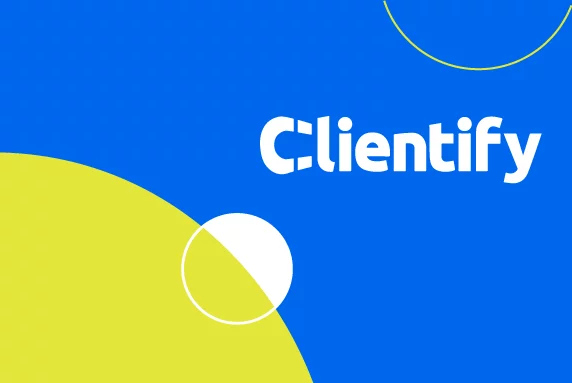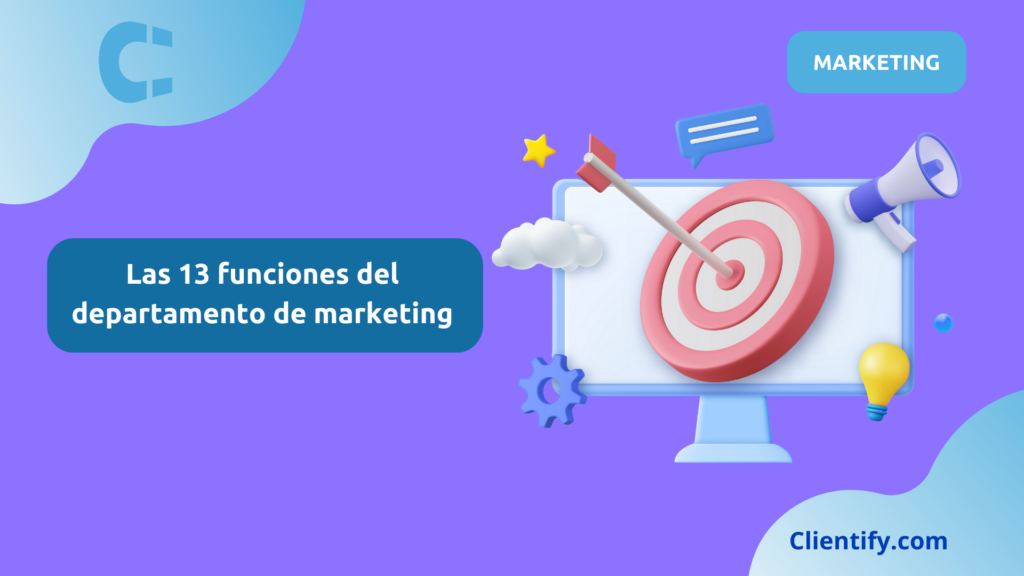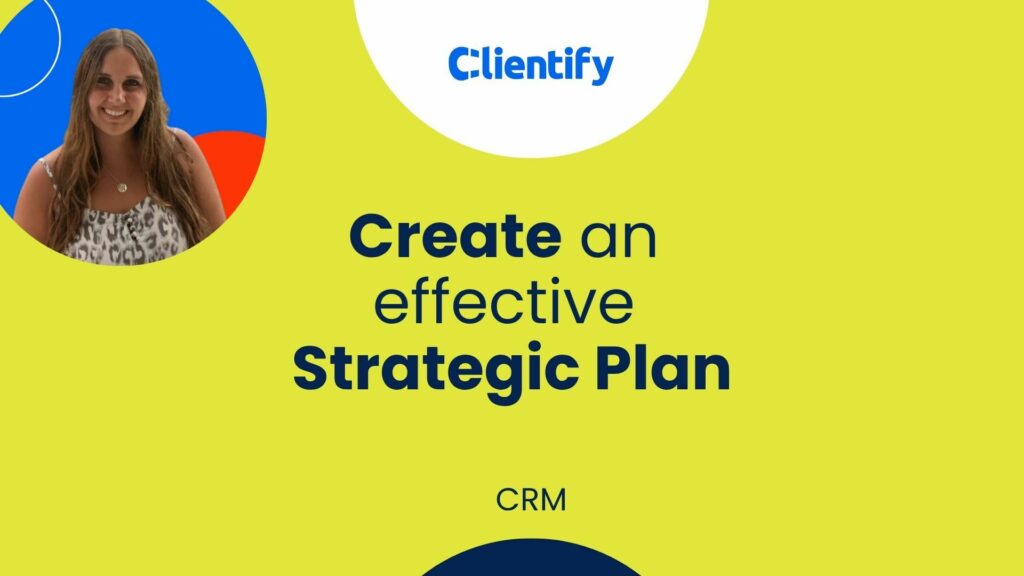There are many ways to reach your customers, but few are as direct and effective as a banner ad.
You’ve probably seen them thousands of times… on TV, on social networks or even on billboards or posters in your city, but have you ever thought about what really makes an ad work and capture your attention?
A good ad not only sells, it also generates emotions, arouses interest and sticks in the memory. That’s the difference between a run-of-the-mill ad and one that really drives a customer to take the next step.
That’s why in this article I’m going to tell you, in a little more detail, what a banner ad is, what its key features are and how an all-in-one platform like Clientify can help you turn that visibility into real sales.
Key ideas:
- What exactly is a banner ad and what is it for?
- The essential characteristics that every advertisement must meet to be effective
- The main types of banner ads and when to use them
- How to leverage Clientify to convert clicks into customers
- Some tips to apply what you have learned in your own business.
What is an advertisement?
A banner ad is much more than a simple message: it is the way companies use to capture people’s attention in seconds andguide them to a specific action, whether it is buying a product, registering for an event or even changing the way they think about a brand.
As stated in the Encyclopedia Britannica, advertising is understood as “the set of techniques and practices used to make products, services, opinions or causes known to the public in order to persuade their response to what is advertised”.
Think of it as a bridge between your business and your audience.
An advertisement has the mission to inform, persuade and motivate, using words, images, sounds, colors…or even a mixture of all of these; and the important thing is that it is brief, clear and attractive enough for the person who sees it to say: “this is just what I need”.
And let me give you a tip: when designing your own ads, always remember to check if they comply with the four basic phases of AIDA persuasion: Attention, Interest, Desire and Action.
- Attention: does your ad stand out and catch the eye of your ideal customer?
- Interest: does it arouse curiosity or make you want to know more?
- Desire: are you able to connect with their needs and motivate them to want your product or service?
- Action: does it clearly invite you to take the next step (click, call, reservation, purchase…)?
The important thing here is that if one of these phases fails, your message loses strength and the return on your investment decreases. Therefore, applying AIDA is not just a theory: it is a practical guide to ensure that your advertising is effective.
The 4 key characteristics of an advertisement
Just as we mentioned before, if you want your ad to really work, it’s not enough just to have a good idea…you need to meet certain characteristics that make the difference between going unnoticed or getting your audience to act.
1. Briefness
Your ad should be to the point. The more concise you are, the easier it will be to capture attention in the first few seconds. In a world full of distractions, brevity is your best ally.
2. Clarity
A convoluted message generates confusion and, when that happens, your potential customer leaves. Use clear, direct language that is understood the first time and makes it clear what you offer and why it matters.
3. Persuasion
The goal is to prompt the person to take an action. To achieve this, appeal to your audience’s emotions, show concrete benefits and use social proof elements such as reviews or testimonials. Persuasion is the engine of every good ad.
4. Target Audience
Never forget who you are writing for. An effective ad is built with a specific audience in mind. If you know your audience well, you will know how to speak to them in their language and connect with their real desires.
What 10 types of banner ads are there and which one to choose for your business?
Not all banner ads work in the same way. Depending on the medium and the objective you are pursuing, your campaign may take different formats.
Knowing the different types of ads is essential; in order to choose the one that best suits your business and the moment in which your customer is.
In addition, when designing your strategy, you must take into account that digital ads are growing all the time.
In Spain alone, digital advertising reached 5,584 million euros in 2024, 12.2% more than the previous year (Laboratorio periodismo). And globally, digital investment is expected to reach 678.7 billion dollars in 2025, representing more than 68% of total advertising spending (Dentsu).
| Type of advertisement | Where it is used | Main objective | Example |
|---|---|---|---|
| In social networks | Facebook, Instagram, TikTok, LinkedIn | Generate fast and segmented interaction | Sponsored post with short video showing a beauty treatment. |
| In search engines (SEM) | Google, Bing | Capturing customers who are already looking for what you offer | Google Ads ad when someone searches for “best aesthetic center in Malaga”. |
| Display | Websites, blogs, news portals | Increase visibility and brand recognition | Banner with your logo and special promotion in a local portal. |
| Television | TV channels in specific time slots | Reaching a mass audience and generating prestige | A 30-second spot showing the transformation with a treatment. |
| Radio | Local or national radio stations | Reaching out to regional audiences and generating proximity | Radio spot on the local radio station with an exclusive promotion. |
| Print (press and magazines) | Newspapers, magazines, brochures | Segmenting specific audiences and giving permanence to the message | Full page ad in a fashion magazine. |
| Billboards | Roads, busy urban areas | Mass branding and visual recall | Billboard with eye-catching image and special discount near a university. |
| Native advertising | Sponsored articles, collaborations, valuable content | Integrate naturally into the consumed content | Post in a lifestyle blog recommending your beauty center. |
| Email marketing | E-mail address | To build customer loyalty and promote direct actions | Personalized mail with a seasonal discount. |
| Digital advertising (general) | Social networks, search engines, YouTube, banner ads | Segment audiences and measure results with precision | Combined campaign with ads on Instagram and Google Ads. |
1- Social media advertising
Social media ads are delivered on platforms such as Facebook, Instagram, TikTok or LinkedIn. They are characterized by their advanced targeting capabilities, allowing messages to be directed to very specific audiences based on age, location, interests or online behavior.
An ad-based marketing strategy should have flexible banner ads (images, short videos, carousels or interactive stories) offers brands the opportunity to be creative and capture users’ attention in a matter of seconds. Moreover, being integrated into the feed or popular sections of the platforms, they are perceived as natural content within the browsing experience.
One of their main advantages is their immediacy: they allow to generate quick interaction through likes, comments, shares or clicks. This interaction not only increases brand visibility, but also facilitates the construction of active and loyal digital communities.
In terms of measurement, social platforms provide detailed real-time data (reach, engagement, CTR, conversions), allowing campaigns to be optimized on an ongoing basis. Because of its adjustable cost and effectiveness in connecting with specific audiences, social media advertising is accessible to companies of any size, from small local businesses to large global brands.
2- Search engine advertising (SEM)
Search engine ads, known as SEM (Search Engine Marketing), appear on platforms such as Google or Bing when users perform searches related to specific products or services. Their great strength is immediate purchase intent, as they are displayed just when someone is actively searching for a solution.
This type of advertising works under a bidding model (CPC), where advertisers pay only when someone clicks on the ad. This makes it a very efficient format, since the investment is targeted to people with a real and explicit interest.
SEM ads can take different formats: from featured search engine results (with links, call extensions or location) to shopping ads with product images. This variety makes it easy to adapt to different stages of the customer journey, whether it’s capturing traffic, generating leads or closing direct sales.
Another key advantage is accurate measurement. Tools such as Google Ads allow you to know metrics such as impressions, clicks, cost per acquisition (CPA) or return on investment (ROI), which makes it easier to optimize campaigns in real time.
3- Display ads
Display advertising takes the form of banners, images, videos or animations that appear on websites, blogs or news portals. Its main objective is to increase brand visibility and reinforce brand recognition in different digital contexts.
One of the greatest benefits of display is its massive reach, as it can appear on thousands of websites within an ad network such as the Google Display Network. This makes it a powerful tool for branding and brand awareness campaigns.
In addition, display offers advanced targeting options: advertising can be targeted according to interests, browsing behavior, geographic location or even remarketing, reaching users who have previously visited the brand’s website.
Design plays a crucial role in the effectiveness of this format. Striking images, clear typography and concise messages increase the chances of capturing the attention of a user who is browsing in another context.
Although the click-through rate is usually lower than in other formats, its value lies in the repeated exposure, which generates recall and strengthens brand presence in the consumer’s mind.
4- Television commercials
Television commercials are commercials that are aired during television programs. They are visual and auditory, which allows for great creativity in the presentation of messages. Although expensive, they have a massive reach and can be very effective.
Television commercials offer a multifaceted platform for creativity and persuasion. Because of the combination of visual and auditory elements, television commercials have the power to generate emotion and capture attention in unique ways. This mix allows advertisers to build complex and memorable narratives that resonate deeply with audiences.
One of the greatest benefits of television advertising is its ability to reach a broad and diversified audience. This type of advertising can be included in specific time slots to target certain demographic segments, thus optimizing the impact of the message. Television campaigns also benefit from high levels of credibility and prestige, as appearing on television can be associated with a quality and trusted brand.
However, television advertising comes with significant challenges. The cost of production and television advertising space can be prohibitively high, making this option less accessible to small businesses.
Moreover, in an increasingly fragmented media environment, capturing viewers’ attention in a content-saturated world requires impeccable creativity and execution.
5- Radio spots
Radio spots are broadcast through radio stations. Although they are auditory only, they can reach a wide audience segmented by region and type of programming. They are a more economical option compared to television commercials.
Despite the absence of visual elements, radio spots have their own set of strengths that make them effective. The simplicity of their format allows them to focus on a clear and direct message, capturing the listener’s attention immediately.
In addition, radio offers unparalleled flexibility in terms of scheduling and frequency, allowing advertisers to adjust their campaigns in real time to maximize their effectiveness.
Another key advantage of radio advertising is its ability to create an emotional bond with the audience. Through the use of familiar voices and evocative sound effects, messages can resonate deeply and be remembered long after their broadcast.
Radio also plays a crucial role in many people’s daily routine, such as during commutes to work, providing regular opportunities for exposure to advertisements.
Finally, since radio commercials are generally less expensive to produce, this form of advertising is accessible to companies of all sizes, allowing for diversity and innovation in advertising content.
However, to maximize impact, it is essential that messages are creative, relevant and well executed, ensuring that they stand out in a highly competitive environment.
6- Print advertisements
Print ads allow for precise segmentation of the target audience, as different types of publications appeal to different demographics. For example, an ad in a fashion magazine may reach an audience interested in trends and style, while an ad in a financial newspaper will capture the attention of professionals and business people.
This specificity is invaluable for brands looking to target their message to a particular audience.
In addition, print ads offer the ability to be both graphic and textual, providing great flexibility in design. The inclusion of high quality images, creative typography and detailed content can create impactful and memorable messages.
This allows advertisers to tell more elaborate and visually appealing stories that can capture readers’ attention and generate greater interest.
Another significant advantage is the longevity of print ads. Unlike other media where messages can be ephemeral, print materials can be saved, revised and shared, thus extending the life cycle of the ad.
This is particularly beneficial for campaigns that require continuous and prolonged exposure.
Finally, although production and advertising space in print media may be more expensive than other media, this investment can translate into a higher return due to the quality and accuracy of the impact.
7- Billboard advertisements
Billboards are large structures placed in strategic locations (such as roads and urban areas) to maximize visibility. They are effective for branding campaigns and for capturing the attention of people in transit. Through their imposing size and strategic placement, billboards have the ability to reach a large number of people in a short time, making them a powerful tool for mass marketing.
Creativity in billboard design is crucial. Because of the short time drivers or pedestrians have to view the ad, the message must be clear, direct and visually impactful. Eye-catching graphic elements and concise text are essential to ensure that the ad is memorable and effectively communicates its main message.
In addition, the demographic reach of billboards is remarkable. They can target a broad audience or a specific segment depending on the location. For example, a billboard near a university may be ideal for student-oriented products and services.
This level of geographic targeting allows advertisers to optimize their campaigns and reach their target audience more efficiently.
The long-term impact of a billboard campaign is also significant. Repeated exposure to the ad can strengthen brand recognition and create a constant presence in the consumer’s mind. This “recall” effect is essential to building brand loyalty and increasing purchase intent over time.
8- Native advertising
Native advertising consists of integrating promotional messages within the content of a medium in a natural and non-intrusive way. It is presented as sponsored articles, blog recommendations, collaborations with influencers or publications in digital media, with the appearance of editorial content or of interest to the user.
Its main strength is its affinity with the context: by integrating itself into the narrative of a medium, it avoids the feeling of interruption generated by other advertising formats. This helps the user to perceive the message in a more organic way and with a greater predisposition to trust it.
In addition, native advertising usually provides a high level of engagement, since it offers valuable, educational or entertaining information while positioning the brand as a referent. A clear example is sponsored articles in specialized portals or product recommendations in lifestyle blogs.
Another key advantage is its ability to build long-term relationships with consumers. By offering valuable content rather than just a promotional message, it builds credibility and trust in the brand.
In a digital environment saturated with ads, native advertising has become one of the most effective strategies to connect with demanding audiences looking for relevance and authenticity.
9- Email marketing
Email marketing consists of sending personalized messages via email in order to build customer loyalty, maintain contact and promote direct actions such as purchases or reservations.
Its great strength is personalization: it allows segmenting databases according to interests, purchase history or user behavior, so that each recipient receives a message tailored to his or her needs.
Email formats can range from informative newsletters to exclusive promotions, event invitations or reminders of abandoned products in a shopping cart. By combining creativity in design with relevant content, it is possible to keep users’ interest and generate constant conversions.
Another advantage of email marketing is its high cost-effectiveness. With low cost and accessible automation tools, companies can schedule large-scale campaigns and accurately measure results (opens, clicks, conversions, unsubscribes).
In addition, unlike other more noisy channels, e-mail allows direct and private communication with the customer, generating a closer and more lasting relationship.
Because of its versatility, low cost and ability to build loyalty, email marketing remains one of the most effective tactics in any digital advertising strategy.
10- General digital advertising
With the proliferation of the Internet, digital ads have gained great relevance within advertising strategies.
They include banners, social media ads, Google Ads, YouTube videos, among others. They allow precise segmentation and detailed measurement of results.
The main attraction of online ads lies in their ability to reach specific audiences with a precision that is unprecedented in traditional methods. Digital platforms offer advanced tools to segment audiences based on demographics, interests, online behaviors and geographic data.
This personalization not only increases the relevance of the ad to the user, but also improves the efficiency of the ad spend.
In addition, detailed, real-time measurement of results is another significant advantage. Through accurate analytics and metrics, advertisers can track the performance of their campaigns with key indicators such as impressions, clicks, conversion rates and return on investment (ROI).
This tracking capability facilitates quick adjustments and informed decisions, continuously optimizing the campaign for better results.
The diversity of available formats is another benefit of online ads. You can opt for graphical ads such as banners and videos, paid search ads such as Google Ads, or sponsored posts on social networks. Each format has its own advantages and can be used strategically for different marketing objectives, from increasing brand visibility to generating leads or driving direct sales.
This versatility allows the creation of integrated and coherent campaigns that interact with the consumer at multiple touch points throughout the buying journey.
Finally, the relatively low cost compared to traditional media and the possibility of adjusting the budget in real time make digital advertising an attractive alternative for companies of any size.
How a platform such as Clientify boosts your ads
Knowing what an advertisement is and how to make it attractive is only the first part.
But here comes the key question: how do you make sure that the people who saw your ad don’t get lost along the way? And that’s where an all-in-one platform makes the difference. Clientify is that tool that has a lot of features available and allows you to:
- Centralize the leads that come from your ads on social networks, Google Ads, landing pages, Facebook forms, etc., preventing them from being forgotten in emails or notes.
- Automate follow-up: if someone leaves you their details in an ad, you can immediately send them a personalized email or WhatsApp or assign a specialized salesperson to contact them.
- Measure the results of your advertising campaigns throughclear, easy-to-interpret reports that are updated in real time.
- Connect your communication, sales and marketing actions in one place: your team can see the entire customer journey from the moment they click on an ad until the sale is closed, or not.
And, from experience working with thousands of SMBs, I can tell you that it’s not just about advertising, it’s about having a system that helps you capture, nurture and close sales in a more automatic and effective way, converting those clicks into real customers.
Do it all with Clientify: engage, automate and close sales
Enter for free in the space where Clientify users share tips, help each other and learn how to sell more with AI.
Share your doubts and learn with others who are also growing their business.

Examples of successful advertisements
Analyzing real examples of successful commercials can provide a deeper understanding of how to implement these principles in practice. Here are a few outstanding advertisements
Coca-Cola – “Share a Coke”.
This campaign replaced the Coca-Cola logo on bottles and cans with popular names. The personalization generated an emotional bond with consumers and encouraged product purchase and sharing. The campaign was a huge global success.
Apple – “Think Different”.
Apple’s “Think Different” campaign celebrated innovators and creators who have changed the world. It used iconic imagery and inspirational messaging to position Apple as a brand for those who challenge the status quo. It was a campaign that reinforced the brand’s identity and connected emotionally with its audience.
Frequently asked questions about advertisements
What is an advertisement and what is it for?
An advertisement is a message designed to capture the attention of your audience and motivate them to a specific action. It serves to quickly and persuasively communicate the benefits of your product or service.
What characteristics should an effective advertisement have?
An effective ad should be brief, clear, persuasive and directed to a defined target audience.
What are the most common types of advertisements?
The most common are digital such as display, email marketing, RRSS, SEM and traditional (television, radio, print and billboards). Each one has different advantages and applications depending on your business.
Why invest in digital advertising?
Because they allow you to better segment, measure everything that happens and adjust your investment in real time.
How to measure if an advertisement works?
You should look at metrics such as impressions, clicks, conversions and ROI. With Clientify you can connect your ads directly to the CRM and see the customer journey.
How does Clientify help with banner ads?
Clientify centralizes the leads coming from your ads, automates follow-up with emails or WhatsApp and offers clear dashboards to analyze results.
You know…a banner ad is one of the most effective ways to capture your audience’s attention and lead them to take an action.
But here the important thing is not to think of your ads as isolated pieces…you have to think of them as the gateway to something much bigger. Because in the end,what really matters is not only that someone sees them, but that those people end up becoming customers.
And that’s where Clientify comes in: this all-in-one platform that, in addition to collecting the leads coming from your different ads, can automate their follow-ups, segment them according to their behaviors and interests and measure which campaigns generate the best results.Take advantage of our 14-day free trial and see how Clientify turns your ads into real sales.




